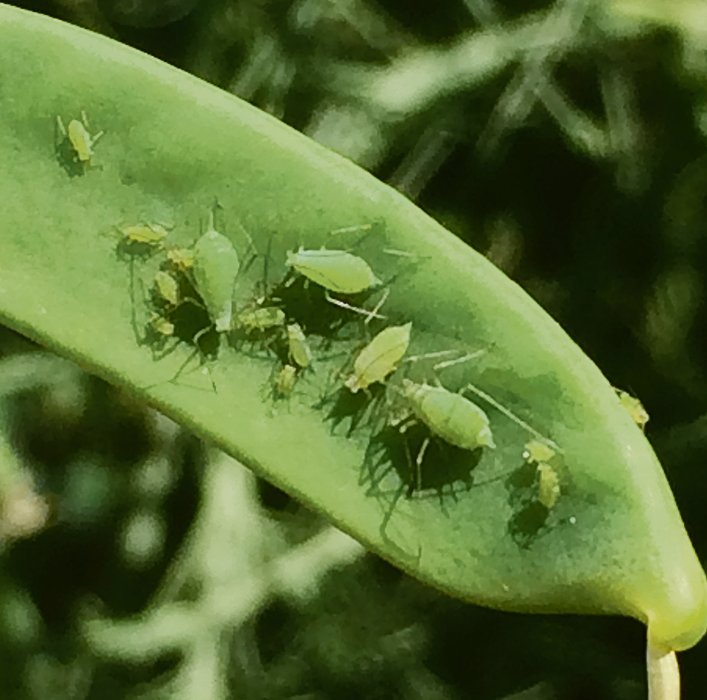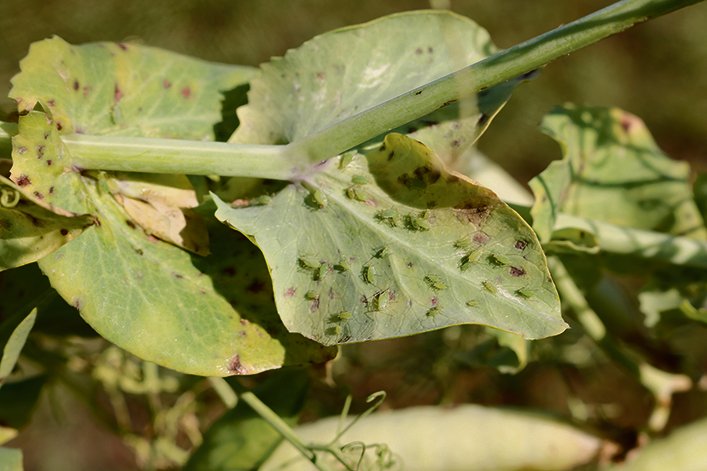Proactive scouting called essential | The Western Producer

Producers are urged to keep close watch on their fields this season as a way to control pea aphids in their pulse crops
Pea aphids.
If you’re a western Canadian pulse crop producer and you haven’t had to deal with them yet, there’s a good chance you will in the near future.
Tyler Wist, an entomologist with Agriculture Canada, said the pea aphid has become one of the most prevalent pests affecting pulse crops in Western Canada.
The insect has been affecting field pea yields for decades but until recently, its impact on other pulse crops such as lentils and fababeans has been largely unknown.
Wist and University of Saskatchewan researchers Sean Prager and Ningxing Zhou are hoping to learn more about how pea aphids can affect lentil and fababean yields.
The research is expected to provide more information to establish better economic thresholds for chemical control.
“They’re probably the worst pest around here for pulse crops,” said Wist.
“They’re named the pea aphid but they’ll get into pretty well any pulse crop that you’ve got out there,” he added.
“Aphid populations can build up really quickly … and they can literally suck the yield right out of a plant.”
Under severe pressure, 100 percent yield loss is possible.
The pea aphid has been around for decades but in recent years, its impact on pulse crop yields have become more noticeable.
In the early 1980s, Ag Canada researchers led by Bob Lamb in Winnipeg established economic thresholds for the aphid in Century peas.
Since then, however, expanding acreage of other pulse crops, including lentils and fababeans, has given the pest a smorgasbord of host crops on which to feed.
A few years ago, Wist was involved in research that looked at the impact that natural predators, such as parasitic wasps and ladybugs, can have on pea aphid populations.
Wist’s research was focused on field peas but it soon became apparent that the pea aphids were feeding on lentils and fababeans as well.
At the time, there were no economic thresholds of when to institute control measures in either of those crops.
Even today, “lentils have only a nominal threshold, which is sort of a best guess scenario…,” Wist said.
“So we set out to take that nominal threshold and see if we could add a little bit more science to it and apply it to the lentils that we grow here on the Prairies.”
There are no pea aphid thresholds established for fababeans, he added.
“It’s such a new crop that no one really knows what kind of effect the pea aphids could have on it.”
Wist’s research, in collaboration with Prager and Zhou, has focused on measuring pea aphid pressure and correlating that to yield losses.
In 2019, pea aphid pressure was measured on a scale of 1 to 5 with a Level 1 infestation representing the lowest level of pea aphid pressure and Level 5 representing the highest level.
Total pressure was measured in cumulative aphid days, which is calculated as the number of aphids observed, multiplied by the time that aphids are actively feeding.
“What we found in the fababean was that once those aphids hit density (Level) 3, it was basically game over for the fababean,” said Wist.
“That was around 100 to 1,000 aphids per plant and the yield was just zero.”
Fababean plants in untreated plots that reached density Level 5 were akin to “sticks in a field” with no pods whatsoever.
Based on that information, Wist and his collaborators have adjusted their pressure ratings in hopes of fine-tuning data and developing economic thresholds that fababean growers can use in their fields.
Fababean plants are most susceptible to aphid damage during flowering. Heavy feeding will cause plants to abort their flowers, resulting in reduced podset.
Despite the pea aphid’s ability to impact yields significantly, the pest has been able to fly beneath the radar of many western Canadian pulse producers.
In addition to working on economic thresholds, Wist hopes to improve scouting techniques and develop new scouting protocols that are more effective and more practical for busy producers.
In field peas, scouting is ideally conducted with sweep nets. Sweep net counts are correlated with aphid counts at the tip of pea plants.
Aphids prefer to feed lower down on the plant, so the presence of pea aphids near the tip of a plant — where aphids are exposed to predators and sub-optimal feeding conditions — is often an indication that aphid populations lower on the plant are extreme.
“If aphids are up there (on the tip of the plant), they’re in a sub-optimal place and they’ve probably been pushed there by lots of aphids further down on the rest of the plant.”
Ideally, a scouting technique will be developed that involves shaking an infested plant in the field and counting the number of aphids that fall onto a plate or some other smooth surface.
The green aphids show up quite well on any white surface, such as a plastic plate, Wist said.
As for timing of scouting, producers or agronomists will begin scouting in early– to mid-July, when pulse plants are flowering.
Scouting should occur every couple of days.
Low numbers of aphids observed during flowering or pod-set may not warrant chemical controls but if aphid populations continue to increase during consecutive scouting sessions, that’s an indication that natural predators are having trouble keeping up with aphid populations.
“It can be hit or miss whether the natural predator can get in fast enough” to provide adequate control, Wist said.
Work on developing economic thresholds and scouting techniques is being augmented by other research.
In Saskatchewan, provincial entomologist James Tansey is looking at timing of chemical applications and crop staging in relation to aphid pressure.
“We’re looking at insecticide timing and seeding timing to see its effects on damage,” Tansey said.
He said that work is still in its early stages. Recommendations for optimal chemical application timing and seeding timing may be available after additional data is collected.
At the University of Saskatchewan, Prager is the principal investigator in a three-year research project that aims to develop new economic thresholds for lentils and fababeans.
The research project, entitled Improved Management of Pea Aphid and Aphid Transmitted Viruses in Saskatchewan Pulse Crops, will also look at the efficacy of different insecticidal control products and the potential transmission of yield-reducing pulse crop viruses by the pea aphid.
Prager said existing thresholds for pea aphids in lentils were established years ago and their applicability to new lentil varieties grown in the Canadian Prairies has not been thoroughly assessed.
New economic thresholds will be established by monitoring pea aphid pressure on replicated plots of lentils and fababeans and correlating that information with yield losses at harvest.
For example, the yields in plots that are sprayed regularly to control aphid pressure at or near zero will be compared to the yields from plots that have heavy insect pressure.
Insect pressure in the plots is manipulated using different chemical control products, including Exirel and Matador.
Preliminary data suggest that in lentils, yield losses will occur a field that produces 1,000 aphids in a 180-degree net sweep.
More detailed recommendations for economic thresholds in lentils should be available later this year.
In fababeans, Prager and Zhou are looking a potential thresholds in the range of 140 to 300 aphids per plant, although those numbers are also subject to further study.
Prager said there is evidence to suggest that the pea aphid is becoming a more serious threat to pulse production in Saskatchewan.
Researchers believe that most pea aphids are blown into Western Canada by winds.
The insects feed on peas, lentils, fababeans, chickpeas, dry beans, alfalfa and clover but peas and lentils are preferred hosts.
When preferred feed sources begin to dry down, aphids will fly short distances to feed on other nearby crops.
A female pea aphid can produce between 50 and 150 offspring per year and new offspring can begin reproducing within a week.
Damage to vegetative crops occurs when aphids tap into the phloem, vascular tissues that carry sugars and other metabolic products from leaves to other parts of the plant.
Wist said researchers are assessing the insect’s ability to overwinter in alfalfa, but it is believed that the bulk of Western Canada’s aphids are blown in from other parts of North America.
“We found that pea aphids can overwinter in alfalfa and come out of the ground, probably as eggs,” Wist said
However, more work is required to determine the insect’s overwintering capabilities.
Researchers are also examining wind data and assessing wind trajectory models to learn more about aphid movements and arrivals.
In lentils, the nominal threshold used by western Canadian producers was originally established by researchers in North Dakota.
That threshold suggests that insecticide application may be warranted when 30 to 40 aphids are captured in a 180-degree sweep, when few natural enemies are present, and when aphid numbers do not decline over a two-day period.
Source: producer.com



